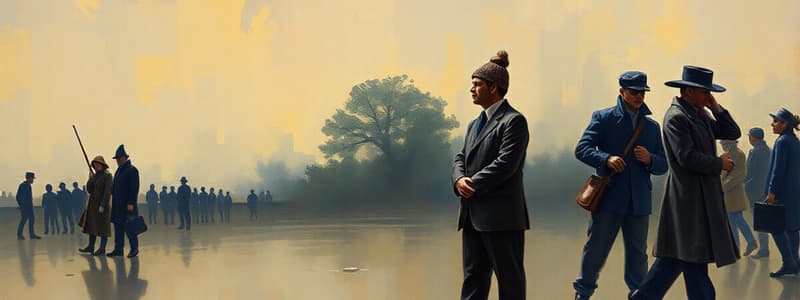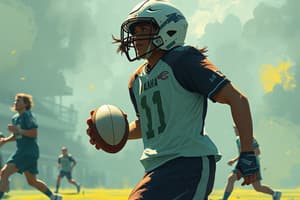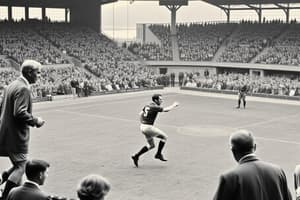Podcast
Questions and Answers
In a meritocratic system, what is the primary determinant of an individual's position within the hierarchy?
In a meritocratic system, what is the primary determinant of an individual's position within the hierarchy?
- The individual's inherent abilities, as recognized by others.
- The individual's access to economic resources and capital.
- The individual's social connections and network.
- The individual's demonstrated performance and effort. (correct)
Which of the following best describes 'equality of condition' in the context of sport and meritocracy?
Which of the following best describes 'equality of condition' in the context of sport and meritocracy?
- All participants start the game with the same amount of money.
- All participants receive the same rewards regardless of performance.
- All participants have an equal chance to participate in a sport.
- All participants compete under the same circumstances, without inherent advantages. (correct)
According to Pierre Bourdieu, what is 'habitus'?
According to Pierre Bourdieu, what is 'habitus'?
- A structured social setting where individuals compete for position.
- External structures that determine one's social class.
- A seemingly innate sense of how to act, influenced by social class. (correct)
- The economic capital available to an individual.
In Bourdieu's theory, what does the term 'field' represent?
In Bourdieu's theory, what does the term 'field' represent?
Which of Bourdieu's four types of capital is most closely related to knowledge, skills, and educational qualifications?
Which of Bourdieu's four types of capital is most closely related to knowledge, skills, and educational qualifications?
According to Canadian Heritage data from 2010, how does participation in sports generally correlate with household income?
According to Canadian Heritage data from 2010, how does participation in sports generally correlate with household income?
Which of the following best describes the primary reason for the rising costs associated with children's sports?
Which of the following best describes the primary reason for the rising costs associated with children's sports?
If a young athlete receives specialized coaching due to their parents' connections with influential figures in the sports community, which type of capital is primarily at play?
If a young athlete receives specialized coaching due to their parents' connections with influential figures in the sports community, which type of capital is primarily at play?
What was the prevailing ideology of Canadian sport by the 1880s?
What was the prevailing ideology of Canadian sport by the 1880s?
A sports team using its historical victories and prestigious reputation to attract sponsors and media coverage is leveraging which type of capital, according to Bourdieu?
A sports team using its historical victories and prestigious reputation to attract sponsors and media coverage is leveraging which type of capital, according to Bourdieu?
A promising young tennis player from a low-income family struggles to compete at the national level primarily due to lack of access to elite training facilities and travel expenses. Which concept best describes the barrier they are facing?
A promising young tennis player from a low-income family struggles to compete at the national level primarily due to lack of access to elite training facilities and travel expenses. Which concept best describes the barrier they are facing?
What fundamental principle did the concept of 'amateurism' in sports reinforce?
What fundamental principle did the concept of 'amateurism' in sports reinforce?
What is 'competitive capital' in the context of children's activities, according to Friedman (2013)?
What is 'competitive capital' in the context of children's activities, according to Friedman (2013)?
In what decade did minor hockey in Canada begin to be formally organized with divisions for young boys?
In what decade did minor hockey in Canada begin to be formally organized with divisions for young boys?
Based on the information, which factors contribute to the high cost of playing competitive hockey in Canada?
Based on the information, which factors contribute to the high cost of playing competitive hockey in Canada?
According to the 2012 Hockey Canada survey, what was the average income level of hockey parents compared to the national median?
According to the 2012 Hockey Canada survey, what was the average income level of hockey parents compared to the national median?
Flashcards
Meritocracy
Meritocracy
A ranking system where performance determines an individual's position.
Equality of Opportunity
Equality of Opportunity
Everyone has the same chance to participate.
Equality of Condition
Equality of Condition
Everyone participates under the same conditions; no advantages.
Class
Class
Signup and view all the flashcards
Habitus
Habitus
Signup and view all the flashcards
Field
Field
Signup and view all the flashcards
Capital
Capital
Signup and view all the flashcards
Economic Capital
Economic Capital
Signup and view all the flashcards
Sports Participation vs. Income
Sports Participation vs. Income
Signup and view all the flashcards
Sport as Investment
Sport as Investment
Signup and view all the flashcards
Hockey Costs
Hockey Costs
Signup and view all the flashcards
Rising Sports Costs: Reasons
Rising Sports Costs: Reasons
Signup and view all the flashcards
Competitive Capital
Competitive Capital
Signup and view all the flashcards
Minor Hockey Origins
Minor Hockey Origins
Signup and view all the flashcards
Amateurism
Amateurism
Signup and view all the flashcards
Amateur Sport Values
Amateur Sport Values
Signup and view all the flashcards
Study Notes
- Social class significantly influences participation and opportunities in sports.
Meritocracy
- The ideal arrangement would position those with the most ability at the top of the hierarchy, through dedication, preparation and effort.
- Reward systems are structured to benefit those individuals.
- Sport introduces children to the demands and rewards of a meritocratic society.
Important Equalities in a Meritocratic System
- Equality of opportunity enables all individuals to engage in a specific event or activity.
- Equality of condition exists participants engage in an activity under the same circumstances without advantages.
- Class is a primary barrier to equality of condition which is essential to a meritocratic structure
Pierre Bourdieu's Theory on Social Class
- Habitus is an innate, practical understanding of how to act, reflecting the subjective side.
- Field is a concept derived from sport, which describes the setting of competition for individuals to compete for ranking.
- Each position in the field holds different rewards and expectations for the players based on their power in the field.
Four Types of Capital
- Capital is comprised of usable resources that individuals or groups possess.
- Economic capital refers to money and property.
- Social capital includes social and institutionalized networks like group memberships.
- Cultural capital includes knowledge, cultural goods like books, and accreditations.
- Symbolic capital includes symbols used to represent themselves to mark distinction.
Hockey and Economic Capital
- Hockey is the second most expensive sport for young Canadians.
- Canadian Heritage reported declining participation in 2010 with income.
- 7% of individuals in families with income below $20,000, participated in sports.
- 15% of individuals with income between $20,000-29,999, participated in sports.
- 20% of individuals with income between $30,000-49,999, participated in sports.
- 25% of individuals with income between $50,000-79,999, participated in sports.
- 33% of individuals with income higher than $80,000, participated in sports.
- Some believe sports instill values for success, viewing the financial investment in the sport as literal investments in life skills.
- Costs include registration in the league, equipment, tournament costs, and transportation.
- A 2012 Hockey Canada survey indicated parental incomes were 15% above the national median, and worked as professional, managers or owners.
- Rising costs reflect child rearing philosophy, educational practices, and use of "leisure time".
- Increasing rates of professionalization in sports build children's "competitive capital".
Minor Hockey for Boys
- In the 1930s, minor hockey began in Canada, creating divisions for boys as young as nine.
- Hockey's institutionalization occurred during debates about the values of amateur and professional sports.
Professionalism and Amateur Sport
- Amateurism suggested athletes should forgo remuneration in competition.
- By the 1880s, amateurism was the standard of CDN sport, where athletes were expected play the game for the sake of honour, pleasure and fun.
- From 1900 on, the class-based element in hockey was replaced by tensions directly between amateur and professional ideologies including racial prejudices.
The NHL Monopoly
- The NHL was established in 1917 among many leagues, improving following the first world war and stable economic conditions.
- In the 1920s, demand for NHL teams increased in urban areas.
- NHL entrepreneurs negotiated market conditions by recruiting capital, building arenas, selling franchises, and speeding up the game.
Importance of Professionalism and Amateur Sport
- Amateur leaders feared youth would be interested in being paid to play hockey in the NHL.
- In the 1930s the Canadian Amateur Hockey Association protected young players from the "evils" of Professional sport.
- By the late 1930s, minor hockey had formally became a feeder system to the NHL.
Studying That Suits You
Use AI to generate personalized quizzes and flashcards to suit your learning preferences.
Related Documents
Description
Exploration of how social class impacts sports participation and opportunities. Discussion of meritocracy, equality of opportunity and condition. Overview of Pierre Bourdieu's theory, including habitus and field.




